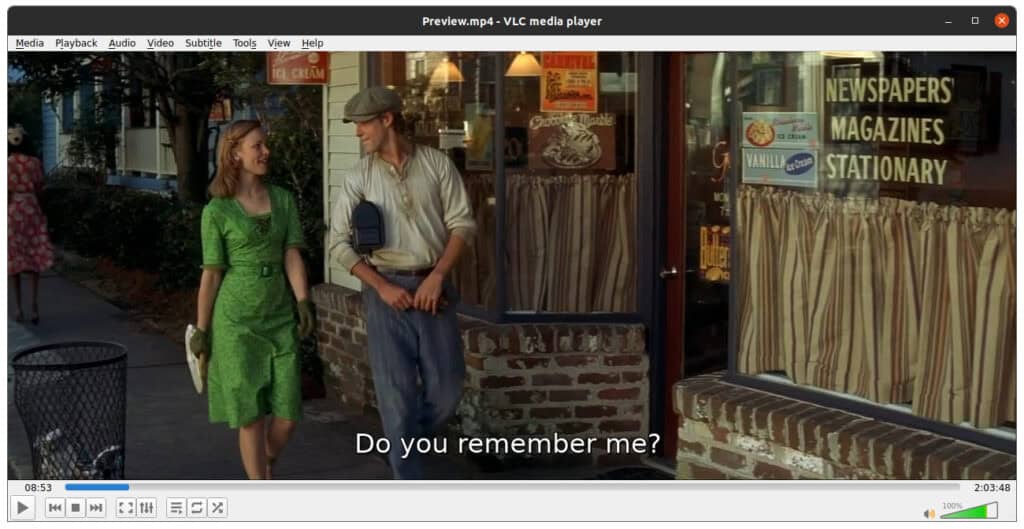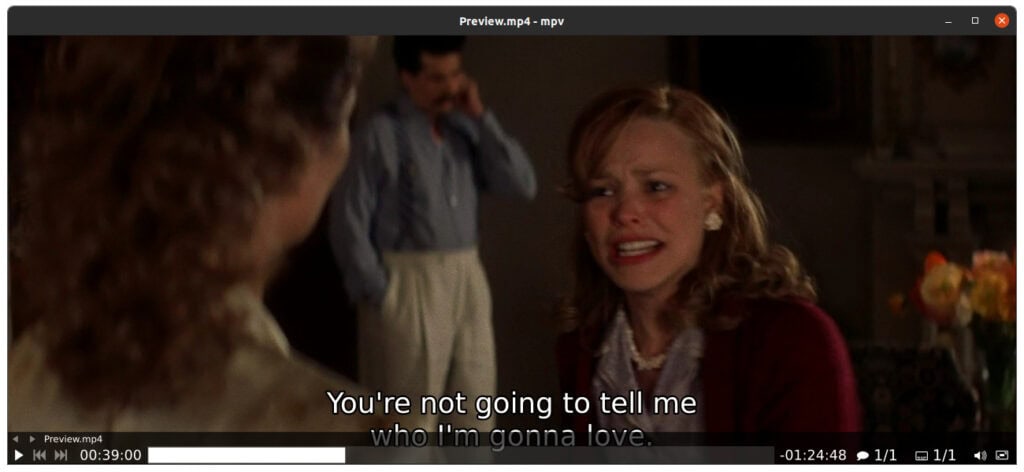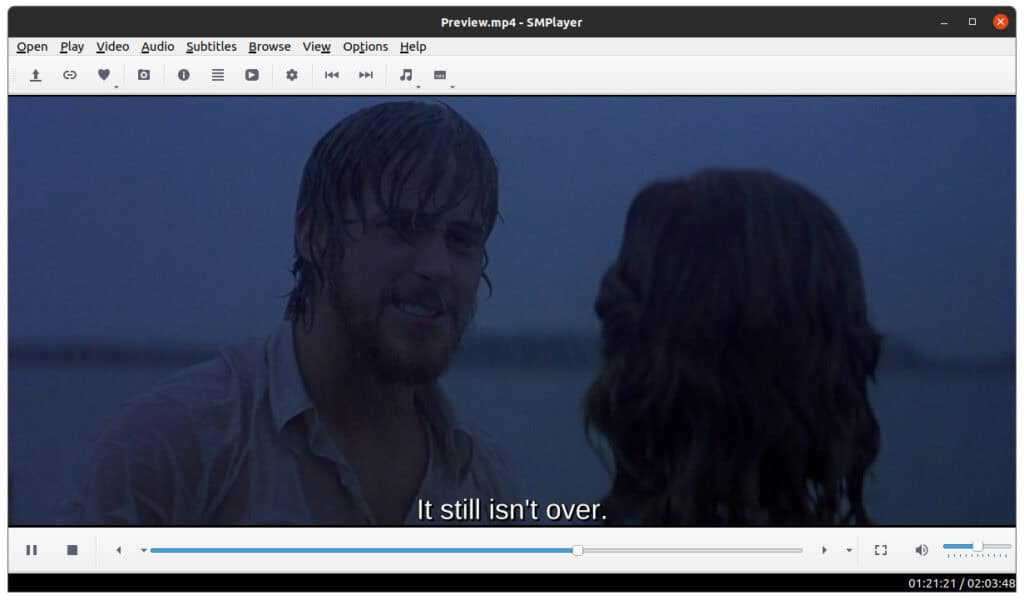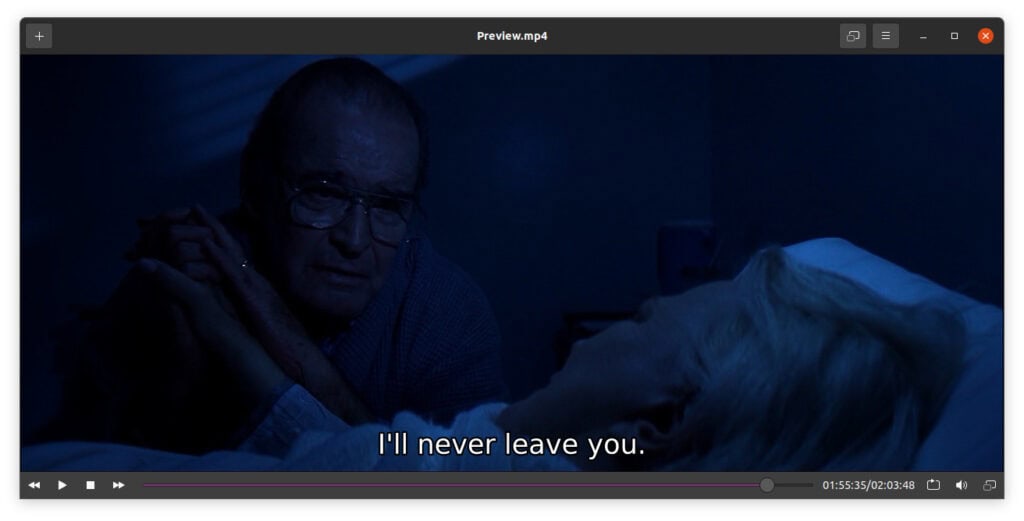There are a lot of free and open-source video players available for Linux today. Most of them do the primary job pretty well. However, some players provide additional features, and you can pick which one would suit you best, depending on the feature list.
1. VLC

The VLC media player is currently the most popular video player for Linux. It is probably at the top of the list of applications responsible for introducing users to open source. VLC can play just about any media format, including internet radio and many videos and audio streaming protocols.
The video support for VLC on Linux is outstanding. If you can’t watch it in VLC, odds are you can’t watch it.
We like best about VLC is the controls that you can use while watching a video. For example, you can slow down or fasten the playback and revert it to normal speed at any time.
In addition, VLC 4.0 will be released later this year with a brand new user interface, making the entire video watching experience more intuitive and full of features for videos of all sorts. So, we can’t wait to see what this amazing media player will provide us soon.
VLC remains the standard by which all other Linux video players should be judged.
Key Highlights
- Plays everything – files, discs, webcams, devices and streams.
- Runs on all platforms – Linux, Windows, Mac OS X, Unix, iOS, Android.
- Convert video/audio, sync subtitles, filter video/audio, and apply other effects.
- Can load your desktop as an input device, effectively turning VLC into screen capture software.
- Hardware decoding – the media loading speed is fast.
2. MPV

MPV is an open-source video player with a minimalist GUI and a feature-rich command-line version. It is a fork of MPlayer.
MPV was forked in 2012 from mplayer2, which was forked in 2010 from MPlayer. It supports various video file formats, audio and video codecs, and subtitle types. Everything MPV needs to play media files is contained within, which means no outside codecs are needed.
MPV has OpenGL-based video output that supports video scaling with color management, high-quality algorithms, frame timing, etc.
In addition, it intelligently caches live streams and enables jumping within the cached stream. MPV The player plays comparatively better 4K videos than other media players available for Linux.
Although many GUI frontends are available, it is mainly keyboard-driven with ample keybindings by default. While it provides intuitive overlay controls when you mouse over it, the interface is best when operated through the keyboard.
This makes MPV extremely quick to operate. In addition, MPV is probably the most powerful and best-documented Linux video player, very professional and efficient.
Key Highlights
- Sleek and minimalist GUI. The whole interface is just a video with a minimal OSD.
- Hardware-accelerated.
- Extremely responsive. Most options for playback are already preconfigured for best performance.
- Many official and third-party GUI front-ends.
3. SMPlayer

SMPlayer is a flexible VLC media player alternative that can play all standard media formats such as MOV, AVI, MP4, DIVX, MPEG, and more with no codecs installed. Just install SMPlayer, and you’ll be able to play all formats without the hassle of finding and installing codec packs.
SMPlayer itself lacks any playback functionality. It acts as a front-end for award-winning MPlayer but differentiates itself from the competition thanks to its extensive features by maintaining its ease of use.
It was launched in 2006, offering an open-source, cross-platform graphical front-end for MPlayer. Compared to other Linux video players in the market, SMPlayer comes with a highly intuitive and interactive user interface.
Overall, it is an excellent media player capable of playing any local or remote multimedia file or stream. The playback mode offers all of the basic features of a media player, including playback speed, zoom, screen rotation, subtitle activation, and jumping to a specific part.
In addition, SMPlayer can play YouTube videos, and it also includes a handy tool that allows to search for YouTube videos.
Key Highlights
- Pleasant interface with easily recognizable options.
- Holding a memory of the time position of each file it has played.
- Variable speed playback (it also allows for frame-by-frame playback, forwards or backward).
- Configurable subtitles with Internet fetch.
- Skinnable user interface.
4. MPlayer

MPlayer is an open-source media player initially developed for Linux in 2000 by the MPlayer team and later for Windows and Mac. It is purely written in C.
Supporting various media formats, MPlayer can also save streaming media for subsequent local playback.
In itself, MPlayer is a command-line media player. It does not offer a GUI like other Linux video players; the users must use the terminal to play different audio and video files.
MPlayer works via CLI and has multiple frontends to choose from. Some more popular frontends include SMPlayer, MPV, GNOME MPlayer, KMPlayer, and Deepin Media Player. In addition, MPlayer has an onscreen display (OSD) for status information.
The best feature of MPlayer is the wide range of supported output drivers. It offers its users a vast and diverse list of output drivers that it can seamlessly support.
MPlayer works with X11, Xv, DGA, OpenGL, SVGAlib, fbdev, AAlib, and DirectFB, but you can use GGI, SDL, VESA, and some low-level card-specific drivers too.
Key Highlights
- No bugs, no lag in the video display.
- Needs no additional codecs.
- Quick skip ahead buttons and other shortcut keys.
- Some of the more popular forks include SMPlayer and MPV.
5. Celluloid

Celluloid is a simple media player and GTK+ frontend for MPV Player. It lets you select where the MPV configuration file is located and enables you to load your custom settings with ease.
The GUI of Celluloid is quite similar to most Linux apps and relatively minimal. It aims to be simple to use while keeping a high level of configurability.
Key Highlights
- Simple graphical interface that follows the recommendations of the GNOME Human Interface.
- Support for drag and drop playlists.
- It is possible to use MPV configuration files.
Bottom Line
So these are the best 5 Linux video players you should try, and all of them work well on Linux.
Thanks to its excellent codec support and a great selection of players, playing media on Linux is easy. We believe you will get the best one which suits you the most.
Please, don’t forget to tell us about your favorite media player in the comments section of this article.

You wrote that SMPlayer is a gui front-end for mplayer but SMPLayer allows the user to choose mplayer or mvp as the video engine. I agree that a big advantage to using a gui is that they allow convenient access to functions as well as options and parameters which might be difficult to discover or tedious to experiment with and or apply. SMPlayer also allows the use of command line flag options and can remember custom settings for individal files. It’s my preferred player. I hadn’t heard of Celluloid but I’ll give it a try!
Hi Warren,
You are definitely right. Thank you for the remark!
Yes, SMPlayer can also be a front-end for MPV.
https://www.smplayer.info/en/mpv